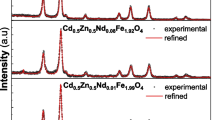Abstract
First measurements of the effective magnetic fields as a function of the depth at which the iron ions are in the surface layer of α-Fe2O3 and FeBO3 single crystals are reported. The method used is the depth-selective conversion-electron Mössbauer spectroscopy. An analysis of experimental spectra revealed that the magnetic properties of the crystal surface vary smoothly from the bulk to surface characteristics within a layer ∼100 nm thick. The layers lying below ∼100 nm from the surface are similar in properties to the bulk of the crystal, and their spectra consist of narrow lines. The spectral linewidths increase smoothly as one approaches the crystal surface. The spectra obtained from a ∼10-nm thick surface layer consist of broad lines indicating a broad distribution of effective magnetic fields. Calculations show that the field distribution width in this layer is δ=2.1(3) T, for an average value H eff=32.2(4) T. It has been experimentally established that, at room temperature (291 K), the effective magnetic fields smoothly decrease as one approaches the crystal surface. The effective fields in a 2.4(9)-nm surface layer of α-Fe2O3 crystals are lower by 0.7(2)% than the fields at the ion nuclei in the bulk of the sample. In the case of FeBO3, the effective fields decrease by 1.2(3)% in a surface layer 4.9(9) nm thick.
Similar content being viewed by others
References
A. J. Freeman, J. Magn. Magn. Mater. 35, 31 (1983); S. Ohnishi, A. J. Freeman, and M. Wienert, J. Magn. Magn. Mater. 31–34, 889 (1983).
A. H. Ovens, C. L. Chien, and J. C. Walker, J. Phys. (Paris) 40, C2–74 (1978); G. Bayreuter, J. Vac. Sci. Technol. A 1, 19 (1983).
T. Yang, A. Krishnan, N. Benczer-Koller, and G. Bayreuther, Phys. Rev. Lett. 48, 1292 (1982); T. Yang, J. Trooster, T. Kachnovski, and R. Benczer-Koller, Hyperfine Interactions 10, 795 (1981).
A. J. Tyson, H. Ovens, and J. C. Walker, J. Magn. Magn. Mater. 35, 126 (1983); A. J. Tyson, H. Ovens, J. C. Walker, and G. Bayreuter, J. Appl. Phys. 52, 2487 (1981).
D. L. Mills and A. A. Maradudin, J. Phys. Chem. Solids 28, 1855 (1967).
U. Gradmann, J. Walker, R. Feder, and E. Tamura, J. Magn. Magn. Mater. 31–34, 1 (1983).
E. Moll and E. Kankeleit, Nukleonik 7, 180 (1965).
B. Stahl and E. Kankeleit, Nucl. Instrum. Methods Phys. Res. B 122, 149 (1997).
B. Stahl, R. Gellert, O. Geiss, et al., GSI Scientiic Report, Darmstadt, Germany (1994), p. 180; R. Gellert, O. Geiss, G. Klingelhofer, et al., Nucl. Instrum. Methods Phys. Res. B 76, 381 (1993).
D. Liljequist, T. Ekdahl, and L. Baverstam, Nucl. Instrum. Methods 155, 5292 (1978).
M. Eibschutz and M. E. Lines, Phys. Rev. B 7, 4907 (1973).
A. S. Kamzin and L. A. Grigor’ev, Fiz. Tverd. Tela (St. Petersburg) 36, 1271 (1994) [Phys. Solid State 36, 694 (1994)]; Zh. Éksp. Teor. Fiz. 104, 3489 (1993) [JETP 77, 658 (1993)].
Author information
Authors and Affiliations
Additional information
__________
Translated from Fizika Tverdogo Tela, Vol. 42, No. 9, 2000, pp. 1644–1648.
Original Russian Text Copyright © 2000 by Kamzin, Stahl, Gellert, Müller, Kankeleit, Vcherashni\(\overset{\lower0.5em\hbox{$\smash{\scriptscriptstyle\smile}$}}{l} \).
Rights and permissions
About this article
Cite this article
Kamzin, A.S., Stahl, B., Gellert, R. et al. Influence of surface on the effective magnetic fields in α-Fe2O3 and FeBO3 . Phys. Solid State 42, 1691–1695 (2000). https://doi.org/10.1134/1.1309453
Received:
Accepted:
Issue Date:
DOI: https://doi.org/10.1134/1.1309453




